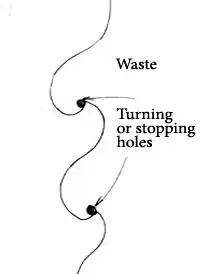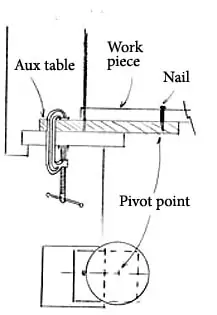Although a band saw is rarely the first stationary power tool purchased for a shop, it is one of the most versatile. A band saw can be used to cut curves, even in thick lumber, as in creating cabriole legs, ripping lumber and even crosscutting short pieces. The most common use is in cutting curves. The second most common use is in resawing or ripping lumber into thinner slabs. A band saw also makes the smoothest cuts and, with the appropriate blade, can be used to cut materials other than wood, including metal.
Band saws are available in a wide range of sizes with different cutting capacities. They are available in small bench and large floor models.
Band saws are available in a variety of sizes, ranging from small bench-top to huge floor models. Bench-top saws are portable and can be placed on a workbench, or bolted to a stand for support. Band saws consist of a pair of wheels that hold its blade, consisting of a narrow band of toothed metal. This band rides on two wheels in the same vertical plane with a space between them. The saws also have a table to support the work and a motor to run it. Older band saws might utilize three wheels. The band saw size determines the stock size it will handle. Size is based on two dimensions—the first is the distance between the inner edge of the blade and the throat of the saws. A 14-inch band saw has a 14-inch measurement between the two.
Some manufacturers may go by the wheel size, which makes the measurement smaller. The second dimension is the depth of cut—the distance between the table and the underside of the blade guide/guard. On a saw with a 6-inch depth of cut, you can actually cut about 5-7/8 inches due to the clearance needed for the guide to ensure easy movement of the work piece.
Most band saws come with a miter fence allowing for crosscutting.
The type and size of table is also important. The larger the table, the easier it is to hold and guide stock through the saw. The table should also have the capability to be set at an angle up to 45 degrees. One use in this mode is removing the corners of a large turning block to speed up stock removal when turning on a lathe. Most band saws also come with a fence, used for resawing, and a miter gauge to use when cross-cut sawing.
Band saw blades ride on rubber- covered wheels. It is important to have proper blade tension to match the blade width.
Blades
Band saw blades are also available in a variety of sizes and tooth styles. Sizes range from 1/8 inch in width up to more than one inch. It’s important to choose the proper blade for the chore. To cut sharp curves in thin stock, choose narrower blades. Move to wider blades for thicker stock. Resawing requires the bigger blades. The pitch or number of teeth per inch of the blade is determined by the hardness of the wood being cut. Hardwoods require a finer pitch or a blade with more teeth. It’s important to have a variety of blades on hand for the different chores. Changing blades is fairly quick and easy on most band saws.
It is extremely important that all the guides be adjusted properly. Better quality band saws feature roller-bearing guides.
Most band saws have tension guide that matches tension with the blade width.
Set-up
Having the band saw in proper adjustment is extremely important. The blade must be tensioned properly and the guides adjusted. Follow your manufacturer’s directions for proper adjustment. The tension is loosened to install or change blades. The blade is positioned in the center of the wheels, and the tension set to the width of the blade, per instructions with the tool. The wider the blade, the more tension required. Blade tension keeps the blade tracking properly. If the tension is set too high, however, the blade will break. With the guard open and the machine turned off and unplugged, slowly revolve one wheel a couple of turns to determine if the blade is aligned properly. If the blade is tracking properly, close the guard and turn on the machine to make sure the blade stays tracking properly.
The blade guides are adjustable up and down to match the thickness of the stock being cut. Quality saws, such as the jet shown, use a wheel for adjustment.
The next step is to make sure the blade guides are adjusted. The back of the blade should just barely touch the rear guide, with the teeth running clear of the guides. Most quality band saws today have bearing guides. The guides should be set so the blade just touches the guides when pressure is applied with the wood. Some models have brass or metal side bearings that must be adjusted in or out, and replaced, filed or turned around as they become worn.
Operation
Using a band saw is fun. As with any tool, proficiency comes with practice. Follow all safety rules with your saw, and always wear safety glasses. Keep your hands clear of the cut line. A band saw is a relatively safe tool, but the blade is sharp and fast and can inflict serious injury in a fraction of a second. Hold your hands on both sides of the cut line and clear of the blade. If a small piece of waste is being cut off, keep both hands on the main piece. If your hands are on the small waste piece, they may slip into the blade as the piece is released by the cut.
When making cuts with sharp curves use several cuts to release various portions of waste stock.
If you haven’t used a band saw before, make practice cuts on scrap softwood stock and then try hardwood scraps. Mark the cut line and move the stock steadily, slowly and firmly against the blade. If you push the stock out of line to one side, the blade will bend and the cut will not be vertical. Do not cut a smaller radius than the blade size can handle. The blade will bind and can jump off the wheel. Instead, cut sharp curves by making a series of relief cuts up to the cut line. Then make a series of short “whittling” cuts to remove the waste between the relief cuts.
Above: Turning or stopping holes can also be used for sharp corners.
Above: Cabriole legs and other mutliple-cut pieces can be created with a band saw by making multiple relief cuts.
Cutting compound curves is a fun practice that can be used to create cabriole legs and other designs. Mark the cuts onto adjoining edges of stock. Cut the waste pieces from one side, tape them back in place, turn the stock 90 degrees and make the two cuts on the adjoining side.
Above: Circles can also be precisely cut with a band saw using an auxiliary table.
You can also cut perfect circles on a band saw with a shop-made jig. First, scribe the circle on the wood and locate the center of the circle. Drill a hole through the center. At the point where the cut is to start, make a cut a couple of inches long tangent to the circle. Fasten an auxiliary table to your band saw table. Position the stock on the auxiliary table with the started cut area against the saw blade. Drive a nail or screw through the hole in the stock to be cut and down into the auxiliary table at right angles to the saw blade. Turn the stock into the band saw blade, allowing the stock to pivot on the screw or nail. You can actually cut a very large circle in this manner, relative to the capacity of your band saw.
Identical pieces can be cut using a follower and a template.
If you have a number of identical pieces to cut, the best method is to use a template and a follower jig clamped to the saw table. Attach the template to the stock to be cut with double-faced tape. Then run the template against the follower.
Band saws can also be used for resawing thick stock into thinner stock. The jet model shown features a bolt-on resaw accessory.
One of the “biggest” band saw chores is resawing, or sawing thick stock into thinner stock. This is often used when highly figured wood is chosen for a door panel or other furniture project. When set up correctly, you can even saw your own veneer. Wide blades must be used. The saw guides must be set properly to keep the blade from wandering. A fence, of course, must also be used. Even with that, there will be some “lead” as the blade tends to saw to one side or the other. The Jet saw shown has a resaw guide that attaches to the saw fence and alleviates the lead problem. A high fence can also be made from wood stock and clamped to the saw table. Saw a scrap stock to determine the lead, and adjust the ends of the fence to account for the lead.
Band Saws on the Go
When it comes to plumbing applications or cutting metal stock on the jobsite, a stationary band saw is not the most convenient tool for the application. A portable band saw can answer the need to make quick cut-offs through tough material. These days, portable band saws are available from Milwaukee Electric, DeWalt, Makita and Porter-Cable.
But only one company currently manufactures a cordless, 28-volt battery-powered band saw, and that’s Milwaukee.

The EHT staff tested Milwaukee’s V28 cordless model, powered by the wonders of lithium-ion technology. We used this saw to cut a variety of pipe and angle iron, and the battery power gave it plenty of muscle—it can hold its own against any corded model. With portable band saws, the weight of the saw does most of the work (trying to force it through stock will likely break the blade), and we found the Milwaukee to make quick cuts through the tough iron. The tool was easy to carry and maneuver thanks to the light weight of the lithium-ion battery combined with the ergonomic front and rear handles. And a two-finger trigger made operation a cinch. The saw also features a handy LED to light the work area. The Milwaukee V28 is a solid choice if you’re shopping for a portable band saw, plus there’s no cord to tie you down. For more information visit www.milwaukeetool.com or call 1-800-SAWDUST.

















